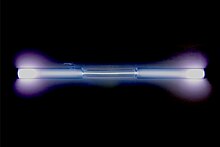Frae Wikipedia, the free beuk o knawledge
Xenon, 54 Xenon Pronunciation Appearance colourless gas, exhibitin a blue glow when placed in a heich voltage electric field Standard atomic weight A r, std (Xe) 7002131293000000000♠ 131.293(6)[3] Xenon in the periodic cairt
Atomic nummer (Z ) 54 Group group 18 (noble gases) Period period 5 Block p-block Element category Noble gas Electron confeeguration [Kr ] 4d10 5s2 5p6 Electrons per shell 2, 8, 18, 18, 8 Pheesical properties Phase at STP gas Meltin pynt 161.40 K (-111.75 °C, -169.15 °F) Bylin pynt 165.051 K (-108.099 °C, -162.578 °F) Density (at STP) 5.894 g/L whan liquid (at b.p. ) 3.057[4] 3 Treeple pynt 161.405 K, 81.77[5] Creetical pynt 289.733 K, 5.842[5] Heat o fusion 2.27 kJ/mol Heat o vapourisation 12.64 kJ/mol Molar heat capacity 5R /2 = 20.786 J/(mol·K) Vapour pressur
P (Pa)
1
10
100
1 k
10 k
100 k
at T (K)
83
92
103
117
137
165
Atomic properties Oxidation states 0 Electronegativity Pauling scale: 2.6 Covalent radius 140±9 pm Van der Waals radius 216 pm Colour lines in a spectral range Spectral lines o xenonIther properties Naitural occurrence primordial Creestal structur face-centred cubic (fcc) Speed o soond (liquid) 1090 m/s ; (gas) 169 m/s Thermal conductivity 5.65×10-3 W/(m·K) Magnetic orderin diamagnetic [6] CAS Nummer 7440-63-3 History Diskivery William Ramsay an Morris Travers (1898) First isolation William Ramsay an Morris Travers (1898) Main isotopes o xenon
Decay modes in parentheses are predictit, but hae nae yet been observed | references
Xenon is a chemical element wi the seembol Xe an atomic nummer 54. It is a colourless, hivy, odorless noble gas , that occurs in the Yird's atmosphere in trace amoonts.[8] chemical reactions sic as the furmation o xenon hexafluoroplatinate , the first noble gas compound tae be synthesized.[9] [10] [11]
Xenon is uised in flash lamps [12] arc lamps ,[13] general anesthetic .[14] excimer laser design uised a xenon dimer molecule (Xe2 ) as the lasin medium ,[15] laser designs uised xenon flash lamps as pumps .[16] waikly interactin massive pairticles [17] propellant for ion thrusters in spacecraft.[18] Dawn Spacecraft .[19]
Naiturally occurrin xenon consists o aicht stable isotopes . Mair nor 40 unstable xenon isotopes unnergae radioactive decay , an the isotope ratios o xenon are an important tuil for studyin the early history o the Solar Seestem .[20] xenon-135 is produced bi beta decay frae iodine-135 (a product o nuclear fission ), an is the maist signeeficant (an unwantit) neutron absorber in nuclear reactors .[21]
↑ Simpson, J. A.; Weiner, E. S. C., eds. (1989). "Xenon". Oxford English Dictionary 20 (2nd ed.). Clarendon Press . ISBN 0-19-861232-X ↑ "Xenon" . Dictionary.com Unabridged . 2010. Retrieved 6 Mey 2010 .↑ Meija, Juris; et al. (2016). "Atomic weights of the elements 2013 (IUPAC Technical Report)" . Pure and Applied Chemistry 88 (3): 265–91. doi :10.1515/pac-2015-0305 ↑
"Krypton" . Gas Encyclopedia . Air Liquide . 2009.
↑ a b Haynes, William M., ed. (2011). CRC Handbook of Chemistry and Physics CRC Press . p. 4.123. ISBN 1439855110 ↑ Magnetic susceptibility of the elements and inorganic compounds , in Lide, D. R., ed. (2005). CRC Handbook of Chemistry and Physics (86th ed.). Boca Raton (FL): CRC Press. ISBN 0-8493-0486-5 ↑
Ackerman, N.; et al. (2011). "Observation of Two-Neutrino Double-Beta Decay in 136 Xe with the EXO-200 Detector". Physical Review Letters 107 (21): 212501. arXiv :1108.4193 Bibcode :2011PhRvL.107u2501A . doi :10.1103/PhysRevLett.107.212501 .
↑ Staff (2007). "Xenon" . Columbia Electronic Encyclopedia (6th ed.). Columbia University Press. Retrieved 23 October 2007 . ↑ Husted, Robert; Boorman, Mollie (15 December 2003). "Xenon" . Los Alamos National Laboratory, Chemical Division. Retrieved 26 September 2007 . ↑ Rabinovich, Viktor Abramovich; Vasserman, A. A.; Nedostup, V. I.; Veksler, L. S. (1988). Thermophysical properties of neon, argon, krypton, and xenon ISBN 0-89116-675-0 . Retrieved 2 Apryle 2009 . ↑ Freemantel, Michael (25 August 2003). "Chemistry at its Most Beautiful" (PDF) . Chemical & Engineering News. Retrieved 13 September 2007 . ↑ Burke, James (2003). Twin Tracks: The Unexpected Origins of the Modern World 33 . ISBN 0-7432-2619-4 ↑ Mellor, David (2000). Sound Person's Guide to Video Focal Press . p. 186. ISBN 0-240-51595-1 ↑ Sanders, Robert D.; Ma, Daqing; Maze, Mervyn (2005). "Xenon: elemental anaesthesia in clinical practice". British Medical Bulletin 71 (1): 115–35. doi :10.1093/bmb/ldh034 . PMID 15728132 . ↑ Basov, N. G.; Danilychev, V. A.; Popov, Yu. M. (1971). "Stimulated Emission in the Vacuum Ultraviolet Region". Soviet Journal of Quantum Electronics . 1 (1): 18–22. Bibcode :1971QuEle...1...18B . doi :10.1070/QE1971v001n01ABEH003011 . ↑ Toyserkani, E.; Khajepour, A.; Corbin, S. (2004). Laser Cladding ISBN 0-8493-2172-7 ↑ Ball, Philip (1 Mey 2002). "Xenon outs WIMPs" . Nature . Retrieved 8 October 2007 . ↑ Saccoccia, G.; del Amo, J. G.; Estublier, D. (31 August 2006). "Ion engine gets SMART-1 to the Moon" . ESA. Retrieved 1 October 2007 . ↑ "Dawn Launch: Mission to Vesta and Ceres" (PDF) . NASA. Retrieved 1 October 2007 .↑ Kaneoka, Ichiro (1998). "Xenon's Inside Story". Science . 280 (5365): 851–852. doi :10.1126/science.280.5365.851b . ↑ Stacey, Weston M. (2007). Nuclear Reactor Physics ISBN 3-527-40679-4



